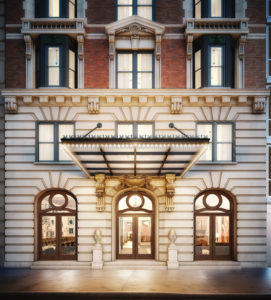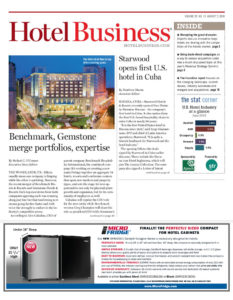NEW YORK—A respect for the old with an eye toward the new has led real estate company Alfa Development to make a foray into the lodging space with the opening last month of HGU New York.
The 90-key boutique hotel is a renovation of a 1905 building at 34 East 32nd St. in Manhattan’s trendy NoMad District. Housing a budget hotel before being acquired, reinvented and given landmark status under Alfa, the building is one of the neighborhood’s Beaux Arts gems, originally designed as a residential hotel by architect Frederick C. Browne.
Michael Namer, founder/CEO of Alfa Development, which is focused primarily on residential, retail and commercial real estate projects—many with historic overtones—decided to leverage the company’s experience in the NYC market and take the plunge into hospitality.
“We felt with our expertise for a very high-end residential downtown experience, we wanted to do a hotel. We felt there were a lot of opportunities because of the zoning, number one; and, number two, because we felt that it was another way to make money in real estate,” said Namer.
Alfa had its eye on the hotel space as far back as 2009 when it set out to enter the industry with the Mott St. Hotel in the city’s Nolita District. “It was really a tough time to get financing but we had all our plans done with [architect]Stephen Jacobs and his group. Unfortunately, financing was zero at the time so it turned into the Mott ‘Not Hotel’ condominiums,” he recalled.
Opportunity rolled around again in 2012 when—after parlaying retail space in a SoHo building the company had completed several years ago—Alfa, for $28.5 million all-cash, acquired the 10-story building that would become its first hotel.
“Thor Equities came in and made me an offer I couldn’t refuse, we took that money and then bought the hotel,” said Namer.
The developer brought in Maryland-based management company Marshall Hotels & Resorts and for the next two years, operated the property, which catered to foreign travelers, under its existing name, Hotel Grand Union (hence the acronym, HGU).
Privately held since 1976, the previous owners, said Namer, “had stripped it down to a very ugly design inside. The rooms were very ugly. I don’t know, they slapped some paint on, put some beds in; they were making money. We made money for two years until we got our plans together.”
Those two years also gave the seasoned developer a much greater insight into the lodging industry and the property’s potential.
“We do a lot of work in landmark districts and a lot of restoration of landmark buildings. It’s one of the attractions I had that made us buy the hotel, besides the fact that it’s in a great location and it was a challenge,” said Namer. “We finally decided to go ahead and turn it into what should have been done because now we knew about the hotel business much more fluently and understood the dynamics and the nuances with Marshall Hotels’ partnership.”
In addition to operations being retooled, Alfa Development brought in designer Peter Guzy of Asfour Guzy Architects and DD Allen of Pierce Allen Design to create a New York-centric environment. Efforts recall the hotel’s past in its public spaces while offering contemporary design in its guestrooms and consider sustainability as part of the overall presentation. For example, within the hotel’s infrastructure, the HVAC system is designed to reduce the property’s carbon footprint by 50%.
Sustainability is one of three drivers behind Alfa Development projects, the others being history and architecture. Each is considered and incorporated where appropriate to present the developer’s vision in the end result.
“When I saw the [hotel’s] facade, I was completely taken over by it and I said this is a beautiful building; it has to be maintained as a beautiful building and it has to have its old grandeur. Ironically, the architect of the building that I live in is the same,” said Namer.
The CEO characterized the building’s “bones” as good but it had needed a major 14-month renovation to modernize its interiors and systems.
“The ’60s,’70s, ’80s and ‘90s were not good to the hotel’s finishes; luckily, they covered a lot of stuff up. Once we uncovered it, we realized there were beautiful plaster ceilings and ornamental wall appliqués that we restored,” he said.
HGU New York’s vibe reflects its residential-hotel beginnings. Guestrooms, from standard queen to king suite, feature Frette bedding, velvet headboards, Turkish rugs and wood cabinetry, along with white bathrooms with subway tiles on the walls and surround, vintage-style mosaics underfoot and a pedestal sink.
“Our concept and our narrative was to make it almost like an Upper West Side pre-war apartment. So when you go into the rooms, you have all the moldings, etc., and then a little bit of Mid-Century Modern, some reference to old, industrial chic items,” said Namer.
Music and art also are a part of the new hotel’s personality. Its “1905” lounge and bar are designed in the style of a living room, with deep seating complemented by a fireplace situated the same as the building’s original one. The space is multi-functional and may be geared toward small meetings and events, including live entertainment and private film screenings, and those looking to relax and decompress.
The hotel also has partnered with Chelsea-based Gallery 151, which is curating an art program that includes urban and emerging artists, as well as pieces from the developer’s private collection. “It’s very eclectic but very compelling to see,” Namer said.
Hoping also to attract writers, Namer noted, “One of our aspirations was The Algonquin [home of the Round Table]as a place in the ’30s where people came and discussed art, music and literature. People had a real hotel culture back in the day. We want to replicate that here.”
The CEO even has added books from his personal collection to the lounge to enhance the space.
Four thousand square feet of F&B space also is in place and at press time, Alfa Development was looking to finalize exactly who would occupy the restaurant space.
Namer indicated HGU New York is a distinct asset, as is the experience it can provide for those coming through its doors.
“We’re just trying to bring back the grandeur of what it was, allow people to be part of it and enjoy a building that’s very eclectic, with one foot in the past and one foot in contemporary New York. We’re very happy with the way it came out,” said Namer.
Being fully booked after three days open probably didn’t bring any frowns to the novice hotel proprietor, either. HB



